The Wonderful Life of a Dying Tree, Presented by Gillian Martin
DATE: Wednesday, February 12, 2020
TIME: 7:30 PM 8:30 PM
WHERE: Baldwin Hills Scenic Overlook Visitor Center, 6300 Hetzler Rd, Culver City 90232
Common Ground Dove | White-winged Dove | Mountain Plover | Pacific Golden-Plover | Red Phalarope | Lesser Black-backed Gull | American Bittern | Little Blue Heron | Broad-winged Hawk | Zone-tailed Hawk | Tropical Kingbird | Pacific Wren | Red-throated Pipit | Lapland Longspur | Chestnut-collared Longspur | Grasshopper Sparrow | Clay-colored Sparrow | Dark-eyed “Pink-sided” Junco | White-throated Sparrow | Green-tailed Towhee | Black-and-white Warbler | Tennessee Warbler | Lucy’s Warbler | Cape May Warbler | Blackburnian Warbler | Magnolia Warbler | Palm Warbler | Summer Tanager | Painted Bunting
Lesser Nighthawk | Pacific Golden-Plover | Sabine’s Gull | Lesser Black-backed Gull | Little Blue Heron | Western Cattle Egret | Broad-winged Hawk | Yellow-bellied Sapsucker | Tropical Kingbird | Chestnut-collared Longspur | Grasshopper Sparrow | Lark Bunting | Clay-colored Sparrow | Orchard Oriole | Rose-breasted Grosbeak | Painted Bunting | Black-and-white Warbler | Tennessee Warbler | Lucy’s Warbler | American Redstart | Cape May Warbler | Magnolia Warbler | Blackburnian Warbler | Blackpoll Warbler | Palm Warbler | Summer Tanager
White-winged Dove | Lesser Nighthawk | Pacific Golden-Plover | Red Knot | Sabine’s Gull | Lesser Black-backed Gull | Little Blue Heron | Western Cattle Egret | Broad-winged Hawk | Tropical Kingbird | Grasshopper Sparrow | Clay-colored Sparrow | Green-tailed Towhee | Orchard Oriole | Baltimore Oriole | Black-and-white Warbler | American Redstart | Palm Warbler | Painted Redstart | Summer Tanager | Painted Bunting
American Golden-Plover | Pacific Golden-Plover | Sabine’s Gull | Franklin’s Gull | Lesser Black-backed Gull | Little Blue Heron | Broad-winged Hawk | Zone-tailed Hawk | Great Crested Flycatcher | Tropical Kingbird | Scissor-tailed Flycatcher | Gray Vireo | Grasshopper Sparrow | Clay-colored Sparrow | Green-tailed Towhee | Bobolink | Baltimore Oriole | Black-and-white Warbler | Tennessee Warbler | American Redstart | Palm Warbler | Rose-breasted Grosbeak | Indigo Bunting | Painted Bunting
Pacific Golden-Plover | Little Blue Heron | Western Cattle Egret | Broad-winged Hawk | Eastern Kingbird | Least Flycatcher | “Black-backed” White Wagtail | Clay-colored Sparrow | Lark Bunting | Bobolink | Baltimore Oriole | Ovenbird | Black-and-white Warbler | Tennessee Warbler | American Redstart | Northern Parula | TROPICAL PARULA | Blackburnian Warbler | Palm Warbler | Rose-breasted Grosbeak | Dickcissel

Esperanza Elementary School Students with Principal Brad Rumble and Los Angeles Audubon staff & volunteers and Baldwin Hills Greenhouse Program students.
Published by Los Angeles Audubon Society in the Western Tanager, Vol 86 No. 3 Jan-Feb 2020
In October and November 2016, staff and Baldwin Hills Greenhouse Program students from the Los Angeles Audubon Society (LAAS) installed a schoolyard habitat at Esperanza Elementary School with the help of students and parents. This habitat is filled with California native shrubs and trees including, California Sagebrush, Black Walnut, White Sage, Gum Plant, and more. There are many benefits to installing this habitat including, but not limited to:
• Educational Resource — Teachers can use it as an outdoor classroom and cover many topics including the water cycle, plant adaptations, habitat, ecosystems and many more.
• Decreases Water Runoff — Permeable surfaces in the habitat allows rainwater to infiltrate the soil, providing water for the plants. This reduces pollutants to be carried away to the ocean.
• Increase in Native Wildlife — Esperanza is listed as a hotspot in eBird with 66 species and counting. Many migratory bird species use the habitat as a stopover site including the Yellow-rump Warbler, Burrowing Owl, and White-crowned Sparrow. In addition, other wildlife are found in this habitat including butterflies, praying mantis, ladybird beetles, native bees species, etc.
• A Greenspace in the City — Los Angeles is highly urbanized, especially near Downtown LA. The younger students are surrounded by asphalt, but this small green space allows for exploration and wonder.
• A sense of community — The surrounding community is brought together for planting and bird-watching.
This past November [2019] LA Audubon staff member, Emily Cobar, concluded two grant projects with the South Bay/Palos Verdes Audubon (SB/PV) and the North American Association of Environmental Education (NAAEE) ee360 Community Fellowship and the Esperanza Elementary School community.
In past Western Tanager newsletters (September/October 2018 and September/October 2019 issues) – Emily covered how she was a recipient of the SB/PV Audubon mini-grant to lead community bird walks and to create calendars for the nature walk participants that included their own artwork and photographs; and how the ee360 opportunity offered her an incredible fellowship that provided professional development and leadership training. Through the fellowship, she also received a grant to provide stipends to college students and/or recent college graduates who lead the nature walks, scientific illustration workshops, and other environmental education activities at Esperanza. In the conservation and education field, there are a myriad of unpaid internships or volunteer programs, so stipends were significant to reward their time commitment and their meaningful work to the community.
The nature walks started with coffee and breakfast for the participants. Then, Esperanza Elementary School principal, Brad Rumble, led a bird walk on campus while the ee360 interns assisted. After the bird walk, the ee360 interns, led a discussion about bird migration and introduced the migration game (an education resource created by Environment for the Americas). The students loved this game as they got to be a bird and go through a migration journey.
After the migration game, we talked about watershed and water runoff. The students conducted an experiment where they pour water on asphalt and then pour water in the habitat. The students got to hypothesize, observe, and draw conclusions on the experiment.
The day had a lot of content, but it was fun and very engaging. A week after the event, one of the young participants said that they wanted to recreate the migration game– which was very meaningful to hear that a simple game can make a big impact. Is this the end though?
No, community building is not a one event type of deal. In 2020 and beyond, Emily and LAAS staff and interns hope to continue this bond of community and nature whether through nature walks or habitat restoration.
Ee360 intern, Angela, pours water on the permeable surface of the native habitat as students observe
Los Angeles Audubon staff and EE360 interns after an interactive day of birding and leading activities.
Group Photo Esperanza Students with Principal Brad Rumble, & Baldwin Hills Greenhouse Program and LAAS Staff & Volunteers.
Younger students playing the migration game, a free resource created by ENVIRONMENTAL FOR THE AMERICAS.
EE360 interns, Charzetta and Dakyra, lead the migration discussion and game on a beautiful Saturday afternoon.
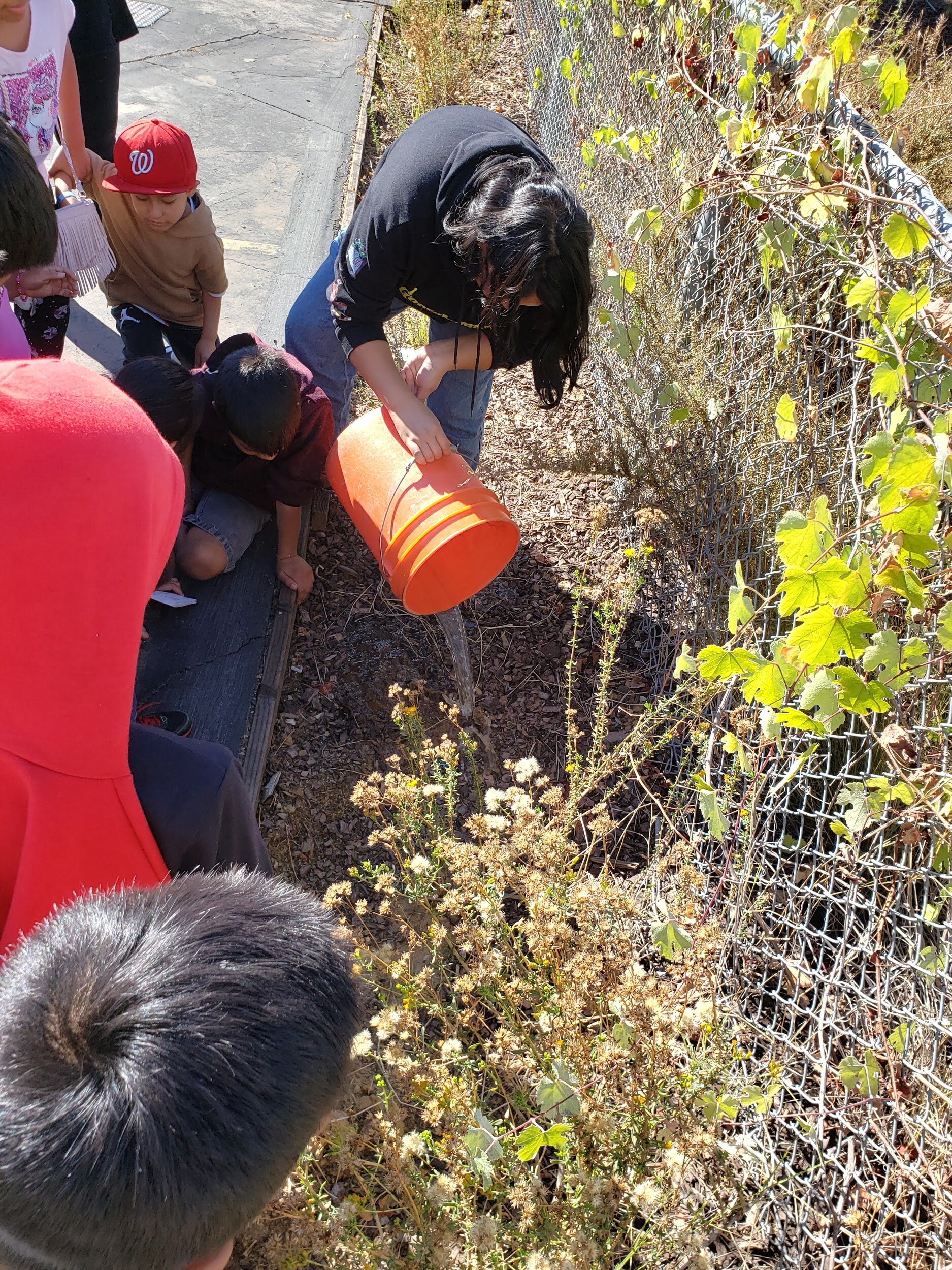
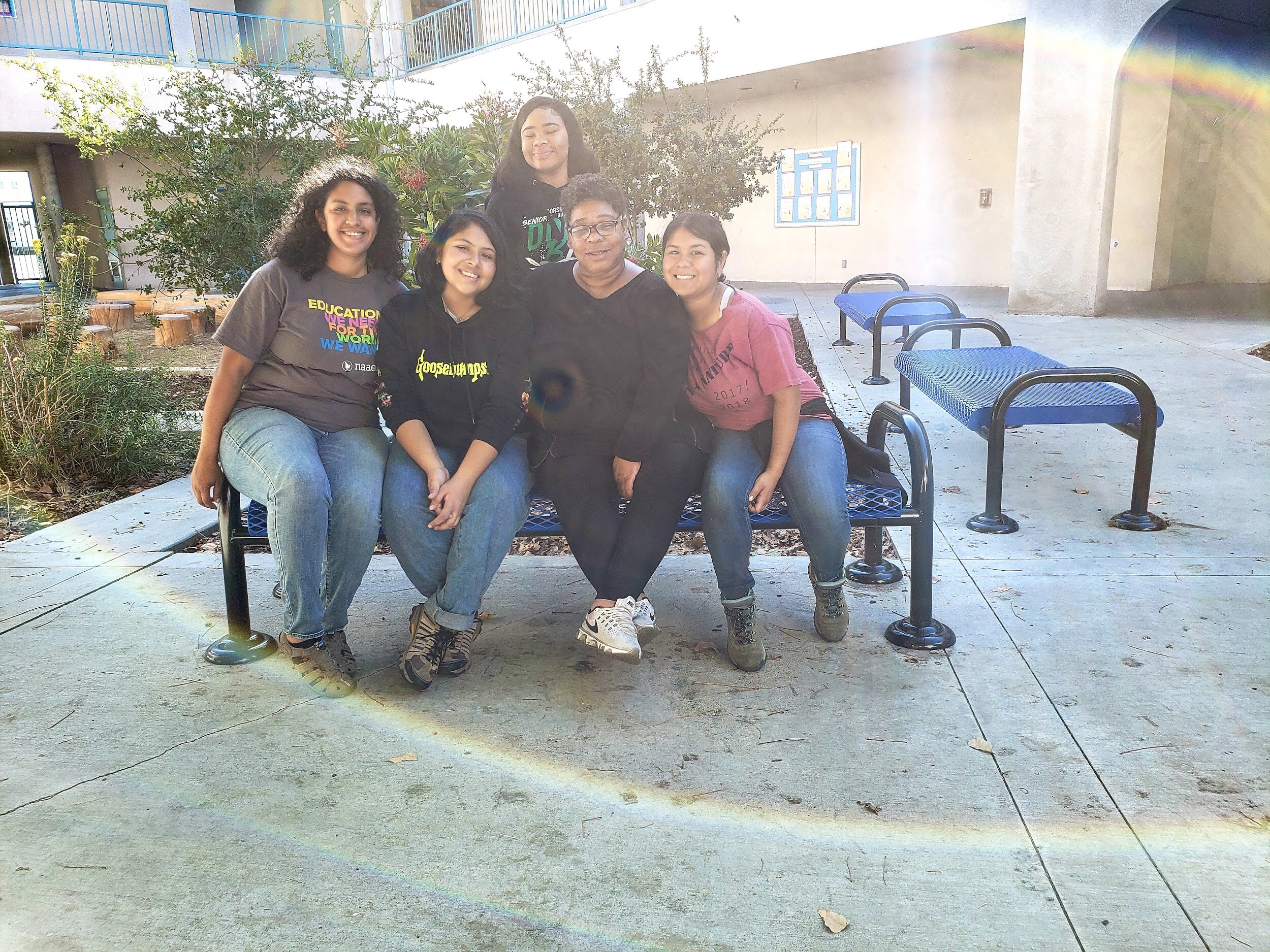
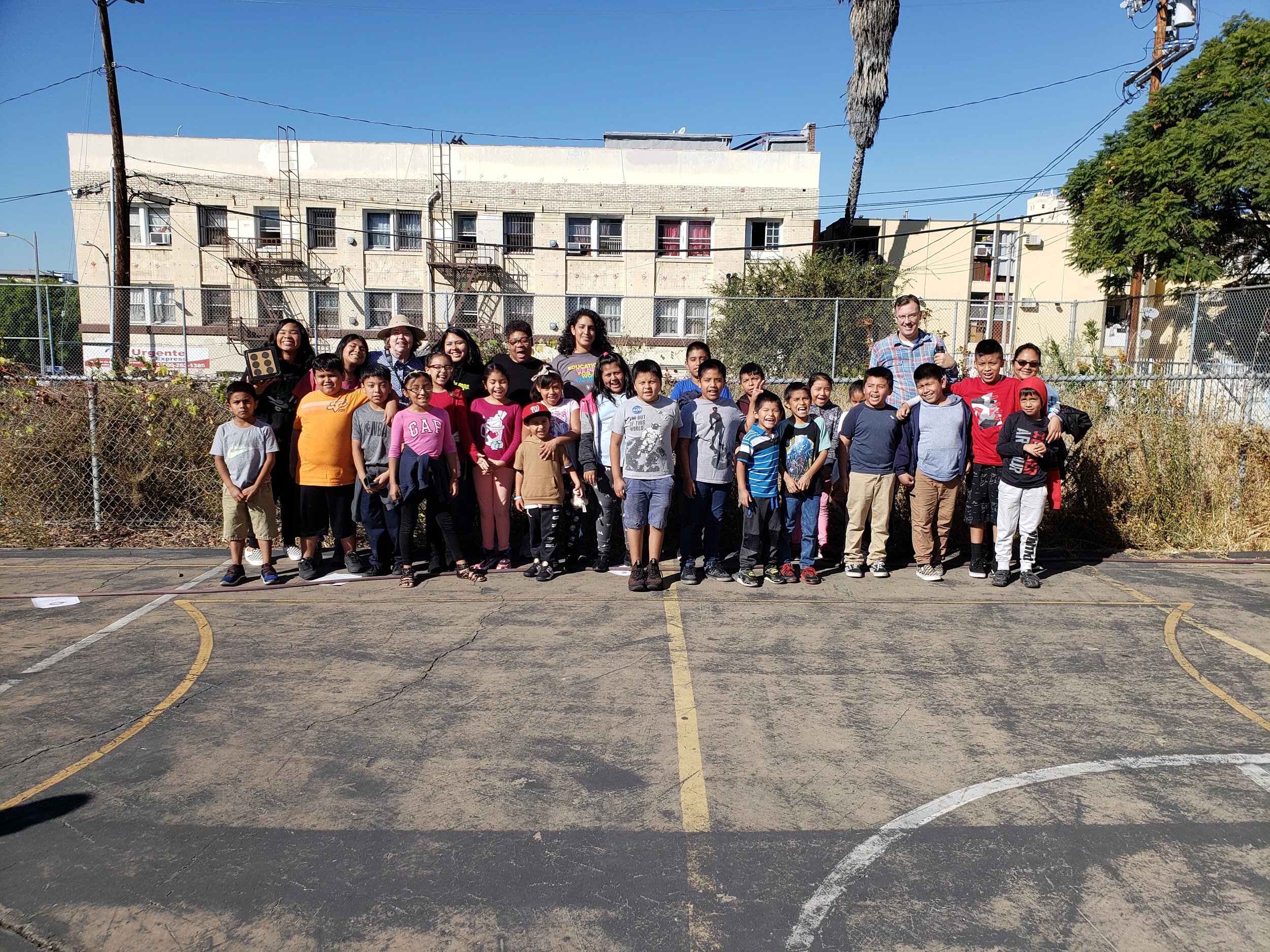

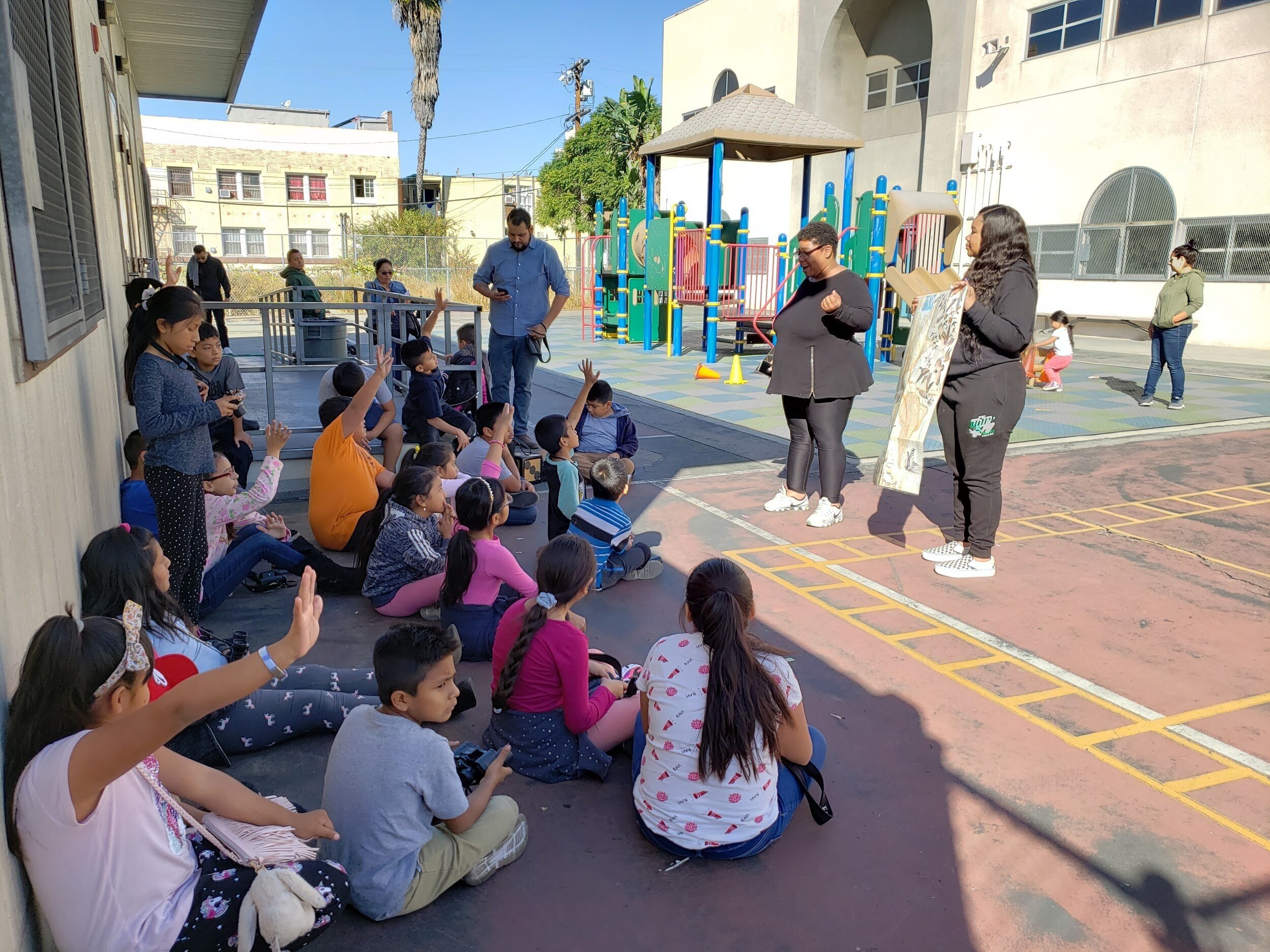
Habitat Restoration and Collaboration
On December 7, 2019, Los Angeles Audubon staff, community volunteers, along with students and their parents, helped to expand Esperanza’s schoolyard habitat. Two areas were planted with native species: the large courtyard at Esperanza Elementary School, and the area along Wilshire Blvd. Students of Esperanza spread out along the campus photographing everyone hard at work and also photographing birds out and about. Rain held out just long enough for a group of hardworking volunteers from Fulbright and from the Westwood Presbyterian Church, as well as students with their families to plant toyon, ceanothus, penstemon, buckwheat and other native plants to attract birds and pollinators. Many of the species were chosen to tolerate shady conditions because the courtyard area is often in part to full shade during the year. Principal Brad Rumble and his students led the group on a campus tour at the end of the planting to view the original schoolyard habitat, planted by the school community and Los Angeles Audubon in 2017 that is thriving with the recent rains.
As the event came to an end, every single person was given the chance to disperse native plant seeds of California Poppies and other perennials onto the habitat area they weeded from invasive plants. The event was supported by US Fish and Wildlife and Westwood Presbyterian Church.
The following photo gallery shows the habitat restoration at Esperanza in progress.
Esperanza Principal Rumble, LAAS Board President and Education Chair Margot Griswold, and Amelia from Fulbright.
Volunteers, students and their parents planting in the Esperanza courtyard.
Long-time LAAS volunteer, Martha Balkan and students plant a Toyon dedicated to Martha.
Fulbright volunteers at Esperanza habitat.
Westwood Presbyterian volunteers at Esperanza habitat.

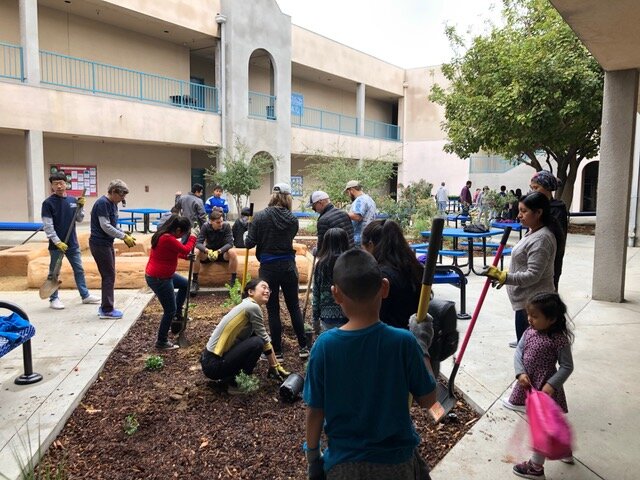
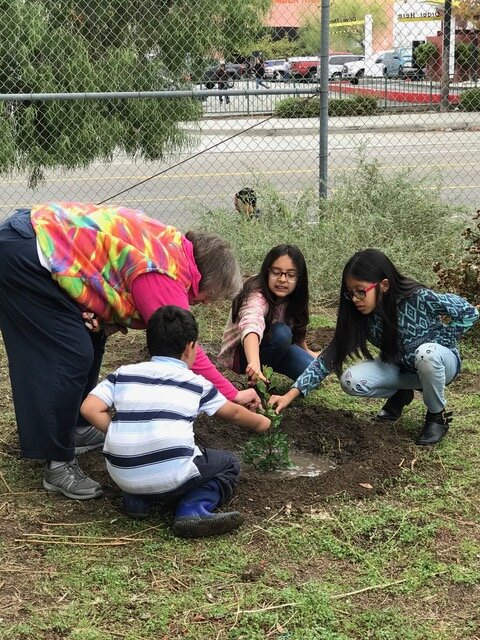
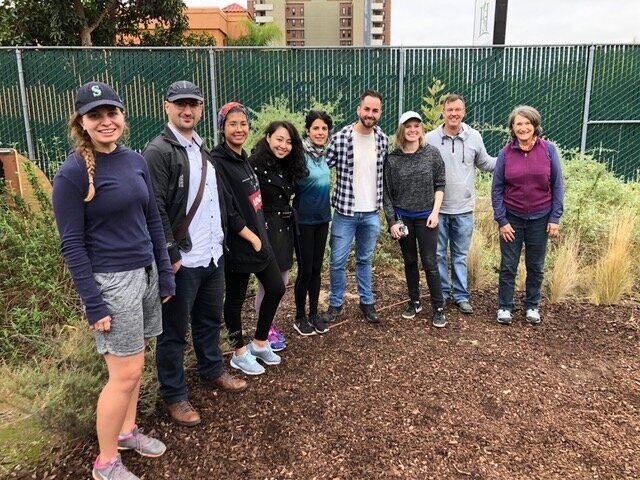
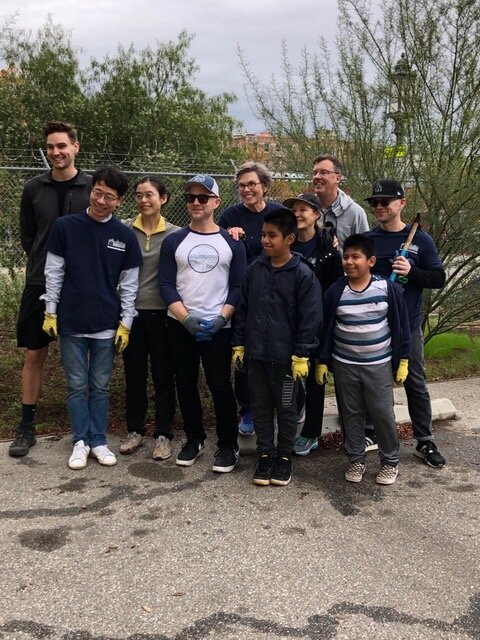

Sign up to join our mailing list to receive our newsletter and updates on upcoming events.